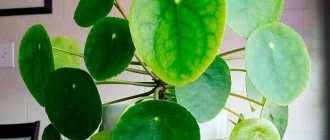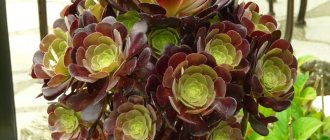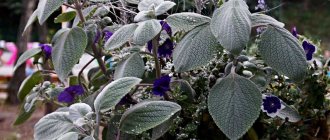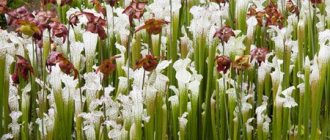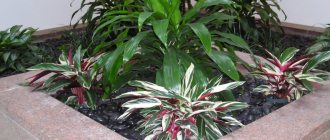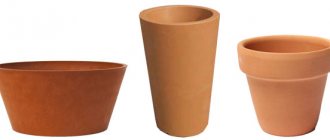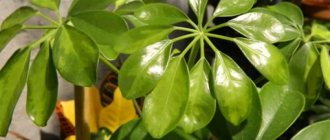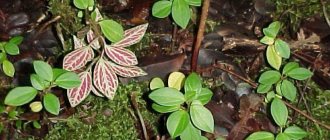Photo gallery
Pilea is the largest genus in the Nettle family. Represented by annual and perennial varieties. In its natural environment, it is common in regions with tropical climates, but is not found in New Zealand and Australia.
You can buy pilea in flower shops and on online platforms. Price from 150 rubles to several thousand.
It is safe for animals, and even useful for humans: the phytoorganic substances of Pilea neutralize pathogenic microbes.
Flowering and fruiting
Pilea grows up to 40 cm, has fragile but fleshy stems. They can be straight, branched or creeping. Oblong, ovate or rounded leaves are arranged oppositely. Often embossed and decorated with colorful patterns. Sizes from 3 mm in diameter to 5–10 cm in length. There are smooth and jagged edges of various shades.
It blooms in summer, but is rare indoors. The flowers are yellowish, pinkish or creamy green and do not attract attention. Outwardly they resemble umbrellas or panicles, located in the axils singly or in the form of inflorescences.
A special feature of Pilea is its ability to catapult fruits over a distance of up to 100 meters. For such fireworks she was nicknamed “Artillery Flower”.
Popular varieties
This crop is not loved for its abundant flowering, although buds appear very rarely at home. This usually happens in the summer season. The flowers are small, white, monochromatic, collected in dense inflorescences. Against the background of bright foliage they are almost invisible.
The following varieties are in greatest demand among gardeners:
Pilea Cadiera
The height of the stems can reach 40 cm. Over time, they begin to branch. The leaves are oval-shaped with a pointed tip and three veins. Other popular names for the species are silver pilea, aluminum plant, which were given to it due to its striking colors. The bright green (or bluish-green) surface of the foliage is covered with two wide, intermittent stripes of a silvery hue.
Pilea adpressed
The leaves are light green, small, numerous. The bushes are squat and curly.
Pilea Depressa
Pilea Alumi
The foliage is colored richly green, has a wrinkled, terry surface with veins of a crimson hue.
Other popular varieties of Pilea include:
- coin-leaved;
- thick-leaved;
- wrapped;
- peperomyoid;
- Lebanese;
- small-leaved;
- creeping.
Cadieux is one of the most common types of Pilea, famous for its variegated leaf color. The plant is unpretentious, so even a beginner can cope with its maintenance. Knowing what Pilea Cadieu is - home care, cultivation, propagation - will help you successfully cope with the task.
Signs and superstitions
Do you believe in signs and superstitions associated with this flower?
I believe I don't believe
Pilea has a positive effect on the atmosphere in the home. When around her, people's anxiety decreases and their mood improves. Suitable for those who practice: in her presence it is easier to enter a meditative state.
It is a talisman for those born under the sign of Pisces. It is believed that Pilea Peperomiiformes has special energy and attracts money into the house, which is why it is also called the Chinese money tree.
According to floral feng shui, you should not keep fading plants at home - they take away vital energy. Give flower pots a place away from the bed and sofa. It is better not to place plants in the bedroom at all. But an excellent solution would be to fill empty niches and corners with them.
Expert opinion
Mokhov Andrey Petrovich
Graduated from KubSAU, specialty: agronomy
Pilea is not suitable for growing as a bonsai, but feels great in open and closed florariums.
Home care
Despite the unpretentiousness of the pilea, depending on the season, the conditions for its maintenance should be adjusted.
| Season | Temperature | Humidity | Lighting |
| Spring | 25˚C, no drafts, diffused light | Increased | Penumbra. The bright sun burns the leaves |
| Summer | |||
| Autumn | Not lower than 16˚С. Optimally 20˚С. No drafts | Moisturize at the beginning of the heating season | The brightest place. You can use phytolamps |
| Winter |
The plant does not go dormant in winter. If you want to take a forced rest, then choose the period from October to February. To do this, maintain a temperature of 18–20˚C, water infrequently, and do not humidify the air nearby.
If you do not regularly trim the pilea, it will quickly lose its compactness, stretch out, and the branches will turn into a tangle. And in order to maintain splendor, at the beginning of spring it is necessary to pinch the shoots. Once every 3–4 years, the flower needs rejuvenation.
It is better to place the plant on the western or eastern side. This is where the diffused daylight he needs will be available. Pilea also feels good in the back of the room, so you don’t have to limit yourself to window sills. And in the summer, even take it out onto the balcony, making a canopy from the sun.
It is easy to provide the high humidity required by the plant in an apartment:
- place a container of water nearby;
- put pebbles, moss or wet expanded clay in the plant tray;
- place a flower nearby whose leaves can be sprayed;
- use a humidifier.
What kind of soil is needed?
Land for Pilea can be purchased in specialized stores or prepared yourself. The composition is not complicated: humus, leaf soil, peat and sand in a ratio of 2:2:1:1.
Expert opinion
Mokhov Andrey Petrovich
Graduated from KubSAU, specialty: agronomy
If you make the mixture yourself, do not forget about disinfection. To do this, the soil needs to be calcined or frozen. It is also recommended to soak it in a solution of potassium permanganate to protect it from pests.
In the store, choose a mixture for decorative foliage flowers with an acidity pH of 5.5–6. A couple of hours before use, stir the soil to saturate it with oxygen. The purchased option is often the best, because maintaining proportions is not everything. It is difficult to find high-quality soil without impurities and diseases.
Transfer
Pilea is replanted immediately after purchase, and then annually from early spring to summer. When transplanting a new flower, the old soil must be removed from the roots.
To do this, place the plant in a container with warm water. Once it's soaked, gently rinse the roots. You can additionally treat them with a preparation like “Kornevina”.
Prepare the pot in advance. A new one should be soaked in water in the evening, and a used one should be rinsed well. The day before transplanting, it is better to water the flower itself abundantly, this will make it easier to remove.
- Place 3 cm of drainage at the bottom of the pot, then soil.
- Remove the pilea from the old planter and place it in the new one. Remove damaged or severely tangled roots. If the flower is fragile, use the transshipment method.
- Add soil mixture.
- Don't compact it, it's better to water it. This will allow the soil to settle and fill the voids. Then you can add more mixture. Do not bury the flower.
- Water the plant.
If the Pilea's leaves change color or wilt, this may be a signal for an urgent transplant into a slightly larger pot than the previous one.
Also monitor the condition of the soil; if a light brown coating and an unpleasant odor appear, it is worth replacing the soil. Do not replant the plant during the flowering period, but if this is necessary due to disease, it is better to cut off the inflorescences.
After replanting, do not disturb the flower for several days; after a week, the soil can be slightly loosened. Do not feed the plant for 2 months after transplanting. Inspect once a week for rot, mold and pests.
Description
The birthplace of the flower is the subtropical and tropical countries of America. The Pilea plant prefers moist, shaded areas. Under ideal conditions, the crop can grow up to 70 cm.
Small Pilea flowers
Indoor small-leaved Pilea is a perennial up to 15 cm high with strongly branching shoots on which small leaves of a pale green hue grow. The maximum size of the sheet plate is 5 mm in length. It is shiny, semicircular in shape, convex at the top, with a solid or carved edge.
The plant rarely blooms in apartment conditions. Small light buds of Pilea, collected in inflorescences, usually appear in early summer and have no decorative value. Many people cut them off so as not to weaken the plant during the flowering period.
Advice! The dense creeping shoots of the flower are suitable for cascading decoration of rooms. Pilea looks beautiful next to plants with erect stems.
Types of flower
Common types of Pilea that can be grown at home:
- Peperomyoid (Chinese money tree). The height of the flower is up to 40 cm. Round, concave leaves on elongated petioles hang from the main stem, which makes them look like umbrellas.
- Silver (other names: Silver, Cadieux). New shoots look up, and old shoots spread along the ground. The leaves are elongated, with carved edges, with 3 veins, along which silvery threads stand out. Thanks to them, this species received its name. The maximum flower height is 40 cm.
- Thread-like. A plant with thin, curly shoots of a reddish hue. The leaves are small, oval, purple underneath.
- Wrapped. At each node of its stem there are 2 leaves with carved edges. The leaf plate is corrugated, with brown veins. The flower grows up to 30 cm.
- Coinleaf. The shoots are creeping, with rounded bright green leaves that look like coins. They are located on small petioles. The lower part of the leaf plate is painted red.
- Lebanese. This is an ampelous pilea with curly shoots of brown color. The small oval leaves on top are pale green, as if coated with silver, and the plate underneath is rich green.
Lebanese Pilea
Pilea flower increases the humidity level in the room. Some species are capable of secreting biologically active substances that stop the growth of bacteria, fungi and other protozoa.
Reproduction
Pilea can be propagated throughout the year by cuttings or seeds. For the first option, use cuttings 7–10 cm long. Place them in boiled water. When the roots appear, the plant is ready for planting.
Cuttings can also be germinated in a mixture of peat and sand. In this case, cover them with glass or polyethylene. It is advisable to plant several pieces in one pot and not leave them in the sun.
Plant transplantation and propagation
Pilea transplantation should be done annually in spring or summer. These plants do not need deep containers, since their root system is quite compact. Pots about 10 centimeters deep are ideal. Due to the fact that Pilea is a plant with random growth, young shoots should be plucked during replanting, and the oldest ones should be cut off. It is quite possible to grow a new flower from cut shoots. Propagation occurs both by cuttings and seeds.
The peculiarity of Pilea Monetolifolia is propagation by self-sowing from seeds formed on the plant itself.
For purchased seeds to germinate, it is necessary to provide them with light and warmth. They should be sown in a flat container with soil consisting of sand and earth. The container should be covered with glass, which should be removed when the first shoots appear. As soon as three or four true leaves are formed, each sprout must be planted in a small pot.
The fastest and most affordable method of propagation is cuttings. For this, blanks 10 cm long are used, which are cut from young apical shoots and placed in moistened sand or soil. For better rooting, it is necessary to create a microclimate by covering the plant with transparent material made of plastic or glass. When propagating Pilea coinifolia by cuttings, to obtain a more lush bush, several cuttings can be planted in a container at once.
This species can also be germinated from a leaf. The lower leaves, cut at the very base of the main stems, are best suited for this. Rooting should be done in the same way as for cuttings.
It should be noted that only some species can produce seeds for self-sowing propagation.
Watering
Watering can only be done with soft water that has stood for several days. In spring and summer, the frequency of watering depends on the speed of drying of the top soil; the rest of the time you should wait a few days. Do not spray the Pilea - excess moisture on the leaves can cause them to fall off.
If you are going on vacation
The best way to preserve your Pilea while you are away is to find someone to take care of them. But if this option is not possible, then there are several ways to prevent the flowers from drying out:
- water the flowers generously before leaving;
- remove the pots from the windowsill and draw the curtains;
- wrap the pots in damp newspaper and place the plant in cellophane;
- trim the buds, thin out the leaves;
- place flowers closer to each other to retain moisture longer;
- buy or make automatic watering;
- use capillary mats.
Problems with leaves
The main indicator of Pilea health is its leaves. You will immediately notice your errors in the content:
- shrink and fall off: the temperature is higher or lower than normal, the soil is too dry;
- lose color, become smaller: lack of lighting;
- turn pale, become lethargic: excessive lighting;
- yellow dry spots appeared: sunburn;
- turn black and fall off: the soil is too wet;
- drooped and lost elasticity: insufficient watering.
Pilea care
An easy plant to grow. It grows very quickly; in one season an adult pilea grows from a cutting.
Temperature and lighting
You need a bright light with protection from direct rays. When there is insufficient light, the leaves turn green and the stems become elongated.
The optimum temperature throughout the year is about 25 degrees. Silver Pilea can be kept at 15 degrees in winter, Peperomyoid - at 10, other species do not like drops to 17 degrees.
Humidity and watering
During active growth, the pilea is watered with soft water as soon as the top layer of soil dries, in winter - after a couple of days. Overwatering is more dangerous for a plant than a lack of moisture - the leaves lose color, become soft, droop and may rot .
Air humidity should be high, but it is not advisable to spray the pilea - its leaves are very delicate and can rot or get sunburned . The easiest way is to place a bowl of water next to the pot.
Fertilizer and feeding
From the beginning of spring to the end of summer - weekly with complex fertilizers for decorative deciduous plants. In autumn, winter - once a month.
Soil and replanting
Can be grown hydroponically. A universal soil is suitable for Pilea. You need a wide, low pot with holes and good drainage. Replanted annually in spring.
Flowering and pruning
Blooming Pilea Pilea
blooms all summer with unremarkable small flowers. In the spring it needs drastic pruning - leave 8-10 cm of shoots, the rest are used for rooting . Once every 2-3 weeks during the growing season, the tops of the shoots are pinched to enhance branching and be more decorative.
Features of cultivation
- In summer, the pilea can be taken outside to a shady place.
- The plant must be protected from cold drafts.
- In winter, the leaves should not touch the window glass, otherwise they will turn black.
- The sawdust with wrinkled leaves is cleaned of dust using a brush.
Diseases and pests. Table
| Diseases and pests | Causes | Symptoms | Ways to fight | Prevention |
| Rot of stems and roots | Frequent watering, especially in a cold room, leads to the appearance of fungus. | Wet soil, lifeless plant appearance, stems at the base soft and watery, leaves falling off. | Replanting into new soil. Treatment with Topaz. | Water the plant correctly. |
| Spider mite | High air temperature and insufficient humidity. | Dots on leaves that eventually merge into spots. The leaves fall off and there is a thin cobweb on their backs and stems. | Treat with Aktara, Fufanon or Decis. | Maintain the required level of humidity. If the pest has appeared recently, rinse the plant under a warm shower. Shake the water off the leaves and let dry. |
| Mealybug | White cotton wool-like sticky discharge. | Treat with Aktara. | Shake the water off the leaves and let dry. | |
| Thrips | Black or gray insects, larvae on the back of the leaf. Colorless spots and silvery coating on the leaves. | If the damage is severe, then treat the flower with Fitoverm: 2 ml per 200 ml of water. After this, put the bag on the flower and leave it for 24 hours. "Actellik": ampoule per liter of water. Use the solution only in fresh air. | Glue traps, treatment with celandine infusion, replacement of the top layer of soil. | |
| Shchitovka | It is impossible to notice young individuals with the naked eye. Adults have a brown shell. The affected plant becomes deformed and the leaves dry out. | Treat with Fitoverm and Actellik. Repeat after a week. | If you find an insect, remove it with a cloth soaked in a mild soap solution. Be sure to monitor the plant for a couple of weeks. |
If the rules of care are not followed, the flower weakens. This can lead to the development of diseases and pests.
Pilea monetifolia
In its homeland, which is South America, this plant naturally lives in shaded areas of tropical rain forests.
In indoor floriculture, the plant is used as a potted, ground-blooded and hanging plant. It is planted together with upright, large species of indoor trees, bushes and flowers.
The variety in question is the shortest, with creeping stems and small (diameter - 1 cm) leaves, similar in appearance to coins. Due to these properties of the leaves, the plant is popularly called “Japanese dollar”. The upper part of the leaves seems to be quilted. Their color is green above and reddish-purple below. And the stems of this variety are reddish, which, in combination with the green foliage, gives the plant a special decorative and showy appearance.
Types of Pilea with photos and names
Cadiere, Cadiere or silver (Pilea cadierei)
It is distinguished by large oval leaves with two silvery intermittent stripes.
Kinds
Pilea cadierei (silver Pilea) / Pilea cadierei
Lives in Southeast Asia in tropical forests. This perennial herbaceous plant grows up to 40 cm in height. Young stems are erect, mature stems are lodging, highly branched, succulent and bare. Beautiful leaves on petioles, elongated oval in shape and pointed towards the apex, have three veins; leaf width is up to 5 cm and up to 20 cm in length. In England this flower is called the “Aluminum Plant”, and in Germany it is called the “Silver Pilea”. The reason is two silvery broken lines running along the green-blue or bright green leaf plate. The flowers of the plant are small, collected in racemose axillary inflorescences. Slender young shoots begin to curl with age, taking on the appearance of an ampelous shape. The plant needs to be pinched to increase bushiness.
- How to plant Achimenes correctly (video)
Pilea microphylla
Perennial plant, herbaceous. Grows up to 15 cm in height. The shoots are branching, densely covered with leaves, touching the ground, and take root easily. Beautifully curving branches look like fern fronds, densely covered with tiny glossy light green round and oval leaves (up to 0.5 cm in length). Corymbose inflorescences of small flowers, both bisexual and heterosexual, are collected in the axils of the leaves. This species is also called “Artillery” or “Cannonier” due to the fact that the staminate flowers form a cloud of dust when the anthers open. The Pilea will release a haze of pollen when touched in the summer.
Pilea nummulariifolia
This is a perennial herbaceous type of pilea, with 40-centimeter shoots creeping along the ground. The leaves are round and light green in color. As the plant develops, it grows and covers the ground.
Pilea involucrata
This pilea is a low bush (about 30 cm). The stem is erect; leaves are up to 7 cm long, oval with a pointed apex, opposite. The leaves are light green, brown and lumpy along the veins. This species is widely used for hybridization.
Pilea peperomioides / Pilea peperomioides
The plant has a very rigid stem and rounded leaves.
Pilea repens
The small bush has creeping stems, and the bush itself grows to a maximum of 25 cm. The leaves are glossy, up to 2.5 cm long, rounded, and the edges of the leaves are wavy; the leaves are arranged oppositely. The color of the upper part of the leaves is dark green with a copper tint, the lower part is purple.
Pilea spruceana
This Pilea is native to Venezuela and Peru. The leaves are arranged oppositely; leaf shape – round or ovoid, rotated 180°, or sharp or blunt at the top; petioles are short. The color of the leaves is shades of silver or bronze.
Pilea "Bronze" / Pilea "Bronze"
A bush with erect stems, growing up to 30 cm in height. The 7-centimeter leaves are arranged oppositely and have an oval shape with a point at the top. The leaves are wrinkled, silvery, and dark green along the veins. Another color of the leaves is a silver stripe along the midrib, and the edges are dark green.
Pilea "Norfolk" / Pilea "Norfolk"
The origin of this form remains a mystery. This is a perennial herbaceous plant. Adult shoots are lodging, and young shoots are erect. The leaves are covered with tiny bristly hairs, velvety and wrinkled, bright green with red-brown veins.
Pilea "Silver Tree" / Pilea "Silver Tree"
It is not clear where this hybrid came from, but this very beautiful perennial pilea is actively climbing. The leaves are oval-shaped, the edges are jagged. The color of the leaves is green-bronze, there is a silver stripe in the middle of the leaf, and the rest is covered with the same spots. Leaves covered with red and white hairs.
